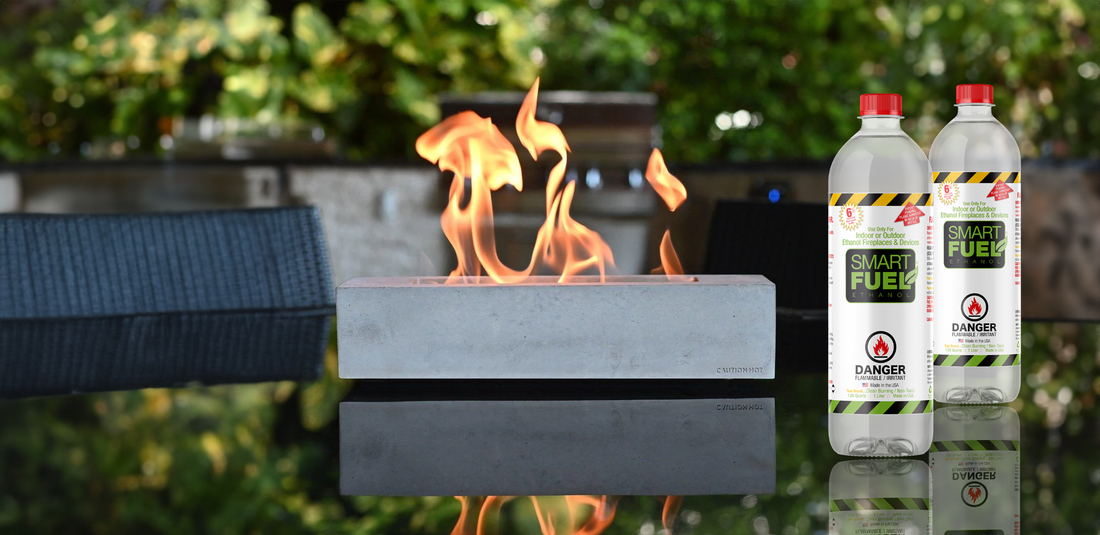
Bio Ethanol vs Isopropyl Alcohol: What's The Best Fireplace Fuel
When it comes to selecting the right fuel for your fireplace or fire bowl, making an informed decision is crucial. Two popular options, bio ethanol and isopropyl alcohol, often vie for attention. While both offer their own advantages, this blog post aims to highlight why bio ethanol is a safer and cleaner choice, emphasizing factors such as emissions, residue, and overall performance.
Emissions: Bio Ethanol Leads the Way
One of the most significant advantages of bio ethanol over isopropyl alcohol is its cleaner burning properties. When bio ethanol is burned, it primarily produces carbon dioxide (CO2) and water vapor. In contrast, isopropyl alcohol can emit potentially harmful and noxious emissions, including carbon monoxide (CO).
Carbon monoxide is a colorless and odorless gas that can be dangerous in enclosed spaces. It poses a significant risk to human health, potentially leading to headaches, dizziness, and even carbon monoxide poisoning. By choosing bio ethanol, you reduce the risk of exposure to harmful emissions, ensuring a safer and healthier environment.

PHOTO COURTESY OF COLSEN FIRE PIT
Residue: Bio Ethanol Leaves No Soot or Residue
Another advantage of bio ethanol is its cleaner burn, leaving minimal residue behind. When burned, isopropyl alcohol can produce soot and other residues that accumulate in the burner, creating a mess that requires regular cleaning and maintenance. On the other hand, bio ethanol burns cleanly, leaving no soot or residue behind. This not only makes cleanup easier but also ensures that your fireplace or fire bowl remains aesthetically pleasing.
Renewable and Sustainable: The Eco-Friendly Choice
Bio ethanol, as the name suggests, is derived from renewable sources such as corn, sugarcane, or cellulose. It is considered a sustainable fuel option as it can be produced using organic matter and does not contribute to the depletion of fossil fuels. Isopropyl alcohol, while also a valuable industrial chemical, is predominantly derived from petrochemical sources, making it less environmentally friendly.
By opting for bio ethanol, you actively contribute to reducing carbon emissions and promoting sustainability. It is a step towards a greener future, aligning with the principles of environmental consciousness and responsibility.

PHOTO COURTESY OF COLSEN FIRE PIT
Ease of Use and Versatility
Bio ethanol is typically available in a ready-to-use form, often in sealed containers or as gel cartridges. This convenience factor makes it easy to handle and eliminates the need for measuring or mixing. In contrast, isopropyl alcohol may require additional precautions during handling and storage due to its flammable nature.
Additionally, bio ethanol offers versatility in terms of design and aesthetics. It can be used in various types of fireplaces, including freestanding units, wall-mounted designs, or even tabletop fire bowls. Its clean-burning properties and lack of odor make it suitable for both indoor and outdoor applications, adding a touch of warmth and ambiance to any space.

PHOTO COURTESY OF COLSEN FIRE PIT
Conclusion
When considering the choice between bio ethanol and isopropyl alcohol for your fireplace or fire bowl, it's clear that bio ethanol emerges as the safer and cleaner option. Its emissions consist primarily of carbon dioxide and water vapor, minimizing the risks associated with harmful gases like carbon monoxide. The absence of soot and residue makes cleanup a breeze, while its renewable and sustainable nature aligns with eco-friendly practices.By embracing bio ethanol, you embrace a fuel that not only enhances the safety and cleanliness of your space but also contributes to a greener and more sustainable world. Choose bio ethanol for your fireplace or fire bowl and ignite both warmth and responsibility in your home.
